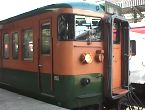|

TRANSPORTATION
TOURISM
PHOTO GALLERY:
Transportation
Shinkansen
Taking trains
Transportation in Tokyo
Rush hour
|
A very short history of Japanese railways:
| 1868: | With the Meiji restoration serious plans for building railways in Japan were introduced. |
| 1872: | Completion of the first railway line in Japan. It connected Tokyo with Yokohama. Soon many private companies were founded, and new lines were built throughout the country. |
| 1889: | Inauguration of the Tokaido line that connects the Kanto with the Kansai plain. |
| 1906: | Nationalization of the railway services. |
| 1945: | At the end of World War II, the Japanese railway system was in a deep crisis that continued for a few years afterwards. |
| 1949: | Foundation of the Japanese National Railways (JNR). |
| 1964: | Inauguration of the Tokaido Shinkansen. Please visit our shinkansen page for more information. |
| 1987: | Privatization of the JNR due to the huge debt: division of the JNR into six private, regional companies: Hokkaido JR, East JR, Central JR, West JR, Shikoku JR, and Kyushu JR. |
The present situation:
Trains are the best means of transportation to get around in Japan. Often this is true for metropolitan transportation as well. Japanese trains are very reliable and punctual.
 The already mentioned JR companies are running urban, regional, and interregional services, including the shinkansen high speed connections. Furthermore, there are many other private railway companies especially in and around the metropolitan areas. The already mentioned JR companies are running urban, regional, and interregional services, including the shinkansen high speed connections. Furthermore, there are many other private railway companies especially in and around the metropolitan areas.
Taking trains is quite expensive, but there is a very good offer for tourists: the Japan Rail Pass. It can be used on practically all the JR services including the shinkansen. It has to be bought outside of Japan and is available for one, two, or three weeks (one week is about $300). Japanese citizens who live outside of Japan can also purchase the Japan Rail Pass.
|